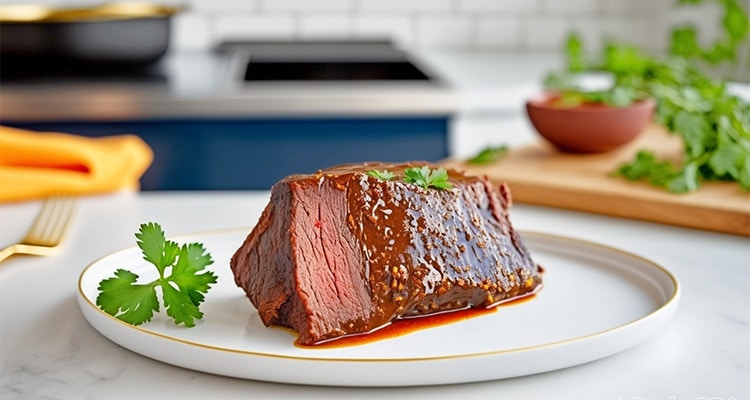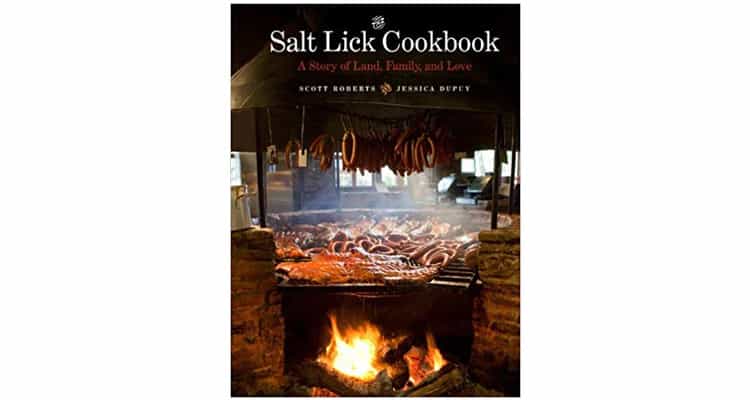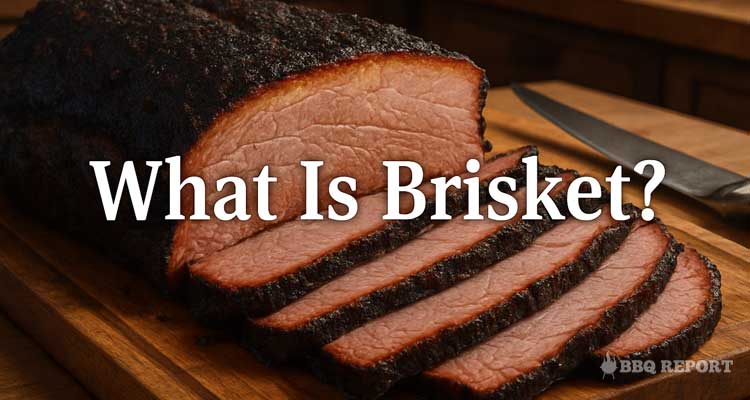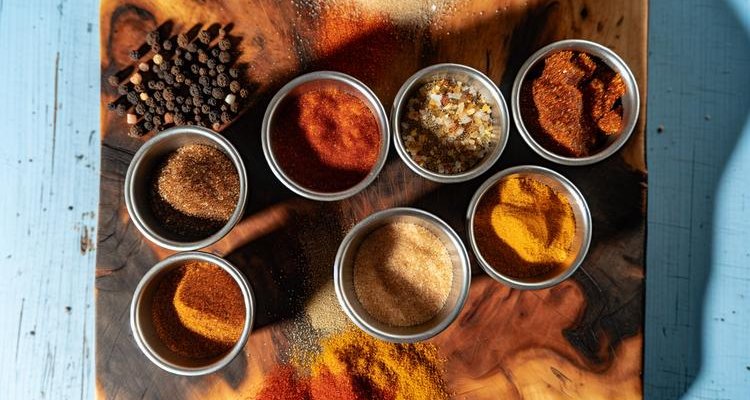
If you’ve ever wondered why some briskets taste like they were kissed by smoke angels while others fall flat, the secret often comes down to the rub. After testing dozens of brisket rub variations over the past few years, I’ve landed on this recipe that strikes the perfect balance between complexity and simplicity. This homemade brisket rub delivers more depth than Aaron Franklin’s famous salt-and-pepper approach, but it won’t overwhelm you with a dozen hard-to-find ingredients like competition-level rubs. With just 8 carefully selected spices, you’ll create a versatile dry rub for brisket that enhances the natural beef flavor while building that coveted mahogany bark we all crave when learning how to smoke brisket.
Why This Brisket Rub Works
I didn’t arrive at this brisket rub recipe overnight. After smoking more than 30 briskets and testing everything from ultra-simple two-ingredient rubs to complex 15-spice blends, I realized the sweet spot sits right in the middle. Franklin’s minimalist salt-and-pepper rub lets the beef shine, which is brilliant for competition-grade prime brisket. But for the choice-grade brisket most of us buy at the grocery store, we need more flavor complexity.
The foundation of this Texas-inspired rub starts with coarse black pepper and kosher salt—non-negotiables for authentic brisket flavor. From there, I’ve added brown sugar for caramelization and bark development, smoked paprika for depth, garlic and onion powder for savory backbone, and just enough chili powder and cayenne to provide subtle warmth without overwhelming the beef. Each ingredient serves a specific purpose, and I’ve tested the ratios extensively to ensure they work together rather than competing for attention.
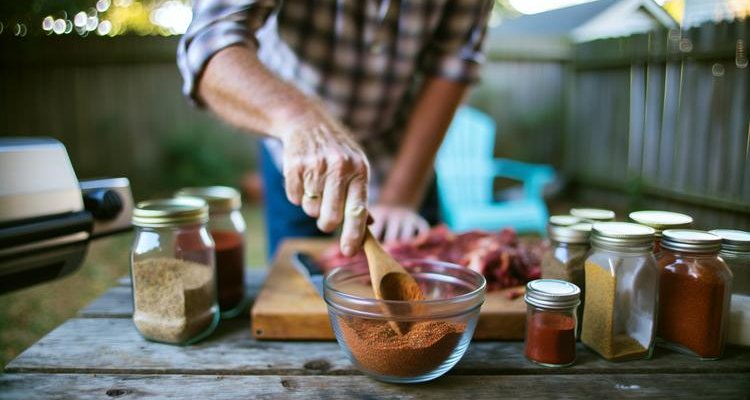
The Secret to Perfect Bark Development
The brown sugar in this rub isn’t just about sweetness—it’s your ticket to that incredible dark crust that makes brisket Instagram-worthy. During the long smoke, the sugar caramelizes and combines with the other spices to form a complex, slightly sweet bark that contrasts beautifully with the tender, juicy meat underneath. I use dark brown sugar rather than white sugar because it adds a subtle molasses note that pairs perfectly with smoke.
The smoked paprika does double duty here. It contributes a mild, sweet pepper flavor while reinforcing the smoke flavor you’re building in your smoker. I’ve found that using smoked paprika instead of regular paprika makes a noticeable difference, especially if you’re working with an electric smoker that produces less pronounced smoke flavor than a traditional offset smoker.
How to Apply This Rub for Best Results
Here’s where many home pitmasters go wrong: they either apply too little rub (leaving bland spots) or cake it on so thick the spices taste harsh and don’t properly adhere to the meat. For a 12-14 pound whole packer brisket that you’ve already trimmed properly, you’ll need about ¾ to 1 cup of this rub—which is exactly what this recipe yields.
Apply the rub in two stages for best results. First, lightly season the brisket all over, then let it sit uncovered in the refrigerator for 1-2 hours. This allows the salt to begin penetrating the meat. Then apply a second, more generous coat of rub, making sure to press it gently into the meat so it adheres. Some people swear by adding a thin layer of yellow mustard or olive oil as a binder first, but I’ve found it’s unnecessary with this particular blend—the moisture from the meat is enough.
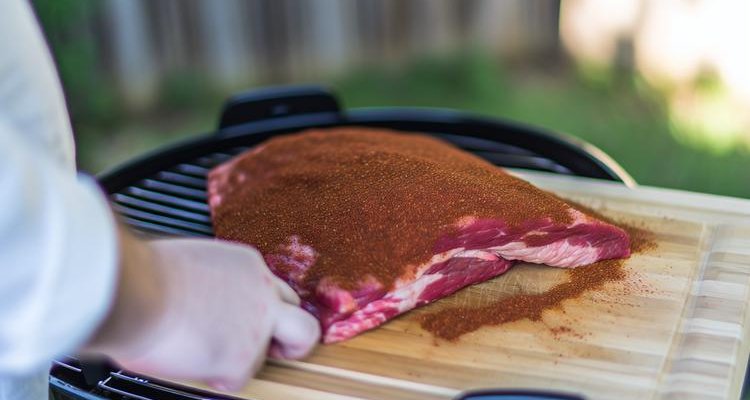
When you’re ready to smoke, take the brisket straight from the fridge to the smoker. The cold meat will absorb smoke better during those crucial first few hours, and the rub will set into a beautiful crust as the temperature slowly climbs. For detailed smoking instructions and temperature guidelines, check out our comprehensive guide on how to smoke brisket.
Storage and Shelf Life
One of the best things about homemade dry rubs is their incredible shelf life. Store this brisket rub in an airtight container or mason jar in a cool, dark place, and it will maintain peak flavor for 6-8 months. I typically make a double batch and keep it in my spice cabinet, ready to go whenever the smoking mood strikes.
The key to longevity is keeping moisture out. Make sure your storage container seals tightly, and never dip a wet spoon into your rub. If you want to get fancy, add a food-grade silica packet to the jar to absorb any residual moisture, though this isn’t strictly necessary if you’re storing it in a dry environment.
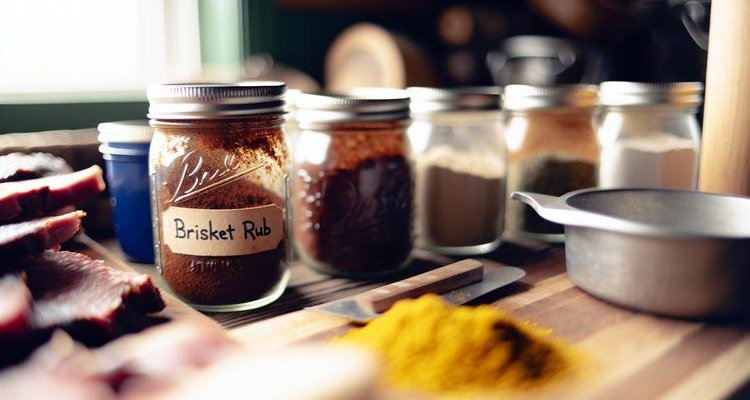
Beyond Brisket: Versatility You’ll Love
While this recipe was designed specifically for brisket, I’ve had excellent results using it on other cuts of beef like beef short ribs, pork ribs, pork shoulder, and even thick-cut pork chops. The savory-forward flavor profile works particularly well with rich, fatty meats that benefit from a long smoke. I don’t recommend it for poultry or fish—the robust flavors will overpower more delicate proteins.
If you’re smoking your brisket on a pellet grill or using a Traeger, this rub works especially well. The consistent temperature control of these grills allows the sugar in the rub to caramelize perfectly without burning. For monitoring your cook, I highly recommend using a wireless probe thermometer to track both the meat temperature and your smoker’s ambient temperature.
If you’re looking for alternatives to this homemade blend, we’ve tested several excellent store-bought BBQ rubs that can save you time, though nothing quite matches the satisfaction of creating your own signature blend. And if you’re interested in expanding your rub repertoire beyond brisket, browse our collection of more BBQ rub recipes for ribs, pulled pork, and chicken. For gift-giving occasions, consider one of the premium BBQ rub sets we’ve reviewed.
The Stall and Wrapping Decision
When your brisket hits the infamous stall around 150-170°F, you’ll need to decide whether to wrap it. If you choose the Texas Crutch method, grab some pink butcher paper rather than aluminum foil. The butcher paper allows the brisket to breathe while pushing through the stall, maintaining that beautiful bark you’ve worked so hard to develop with this rub. The sugar in the rub can get a bit mushy if wrapped in foil, but butcher paper strikes the perfect balance between speeding up the cook and preserving texture.
Once your brisket is done (probe tender around 203°F), let it rest on a quality BBQ cutting board with deep juice grooves. When it’s time to slice, an electric carving knife makes quick work of cutting through the crusty bark without tearing the meat. For finishing touches on the bark, some pitmasters even use a kitchen torch to crisp up any spots that softened during the wrap.
Essential Equipment for Success
While the rub is crucial, having the right equipment makes all the difference in your brisket smoking success. Beyond choosing between charcoal, vertical pellet, or combination smokers, you’ll need reliable temperature monitoring. A good smoker thermometer or wireless meat thermometer is essential for tracking both your pit temperature and meat internal temperature throughout the long cook.
Don’t overlook the importance of proper smoke management either. If you’re using a smaller smoker or want to add more smoke flavor, consider adding a smoke tube filled with pellets. These inexpensive accessories can boost smoke production significantly, especially during the critical first few hours when the meat is most receptive to smoke absorption. For cold weather smoking, a grill insulation blanket helps maintain consistent temperatures and reduces pellet consumption.
Frequently Asked Questions
Can I make this rub in advance?
Absolutely! In fact, I recommend it. Making your brisket rub 1-2 weeks before you plan to smoke gives the spices time to marry and develop a more cohesive flavor. The rub will actually improve slightly as it sits, with the individual spice notes blending into a more unified profile. Just store it in an airtight container in a cool, dark place. I always keep a batch on hand so I’m ready to smoke at a moment’s notice.
How much rub do I need for a whole brisket?
For a standard 12-14 pound whole packer brisket, you’ll need approximately ¾ to 1 cup of rub, which is exactly what this recipe yields. If you’re working with just the flat (the leaner portion), you’ll only need about ⅓ cup. For the point alone, use roughly ½ cup. The goal is complete coverage without excessive clumping—you should be able to see a even coating of rub across the entire surface, with just a slight buildup in crevices where the rub naturally settles.
Can I use this rub on other meats besides brisket?
Yes! This rub works beautifully on beef ribs, tri-tip, beef chuck roast, pork ribs, pork shoulder, and pork tenderloin. The savory profile complements rich, fatty meats especially well. I’ve even used it on thick-cut ribeye steaks with excellent results. However, I’d skip it for chicken or fish—the bold flavors are too assertive for lighter proteins. If you’re applying it to pork, you might want to increase the brown sugar slightly for a touch more sweetness.
How long does homemade brisket rub last?
When stored properly in an airtight container in a cool, dark place, this rub will maintain peak flavor for 6-8 months. After that, it won’t go bad per se, but the spices will start losing potency, especially the more volatile aromatics like garlic and onion powder. For best results, write the date on your container when you make it, and try to use it within 6 months. If you notice the color fading significantly or the aroma becoming muted, it’s time to make a fresh batch.
What’s the difference between this and Franklin’s simple salt-and-pepper rub?
Aaron Franklin’s famous “Dalmatian rub” uses just coarse black pepper and kosher salt in a 1:1 ratio, and it’s legendary for good reason—it lets the beef flavor shine through with minimal interference. That approach works beautifully if you’re working with prime-grade brisket that has exceptional marbling and inherent flavor. This recipe builds on that foundation by adding brown sugar for bark development and caramelization, smoked paprika for depth, and garlic, onion, chili powder, and cayenne for complexity. If Franklin’s rub is a minimalist studio apartment, this is a thoughtfully furnished home—more character and warmth without being cluttered or overwhelming. It’s the perfect middle ground for home pitmasters using choice-grade brisket from the grocery store.
The Recipe
Homemade Brisket Rub Recipe
Equipment
- Medium mixing bowl
- Whisk or spoon for mixing spices
- Airtight container or mason jar for storage
Ingredients
- 1/4 cup coarse black pepper
- 1/4 cup kosher salt
- 1/4 cup dark brown sugar
- 2 tablespoons smoked paprika
- 2 tablespoons garlic powder
- 1 tablespoon onion powder
- 1 tablespoon chili powder
- 1 teaspoon cayenne pepper adjust to taste for heat level
Instructions
- In a medium bowl, combine the coarse black pepper, kosher salt, dark brown sugar, smoked paprika, garlic powder, onion powder, chili powder, and cayenne pepper.
- Whisk or stir the spice mixture until all ingredients are evenly distributed and the brown sugar is broken up with no large clumps remaining.
- Transfer the brisket rub to an airtight container or mason jar. Label with the date and store in a cool, dark place.
- To use: For best results, apply in two stages. First, lightly coat the brisket and refrigerate uncovered for 1-2 hours. Then apply a generous second coat, pressing gently to adhere. Use ¾-1 cup for a full 12-14 lb packer brisket.
Notes
Contents

